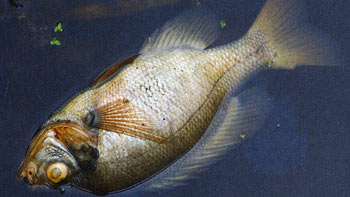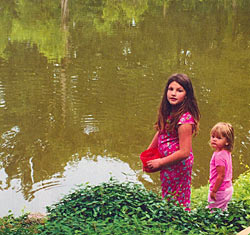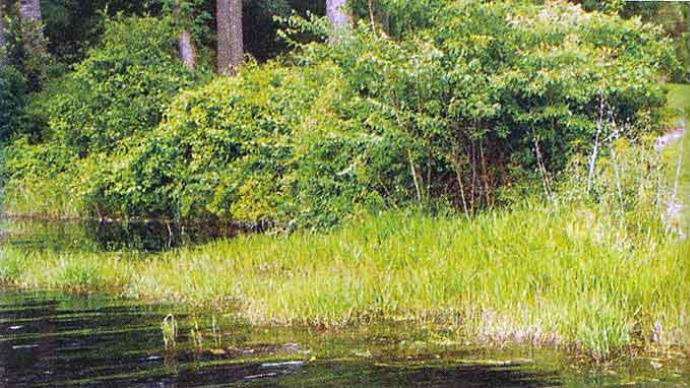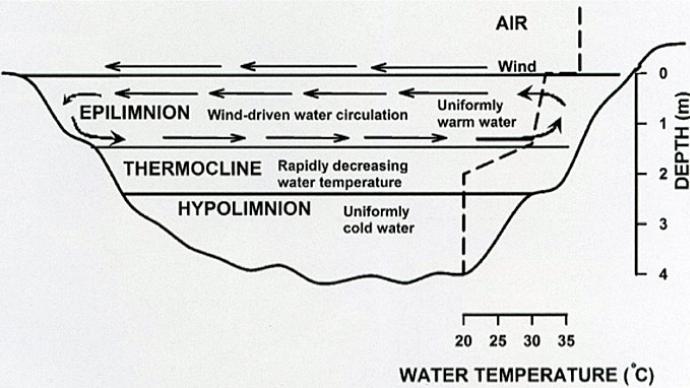
Summer, 2017.
Spring was fun around your mini-pond.
At least it was around ours. Debbie loves to sit outside in the morning, with her first cup of coffee, and talk about the upcoming day and chat about everything on her mind at that moment.
Now that we're in July, there's not so much sitting outside, unless she happens to be up early— earlier than she likes to be up.
During July and August in north Texas, we can expect the later afternoon surface water temperatures of ponds to hit the low 90s. That's hot, anywhere. Sometimes it's hot tub hot. Aerated ponds typically don't get so hot, because the water is moving and adjusts to the average daily temperature, which could still be in the upper 80s in much of the nation.
This is also the time of year we get the most phone calls about problems, especially fish kills and blue-green algae blooms.
Here are some facts you need to know to keep your mini-pond healthy through summer.
First, here's a primer about water. As temperature rises beyond 39°F, water's affinity for oxygen drops. Warmer water physically holds less oxygen than cooler water. As water warms from 39°F, it becomes less dense, which is part of the reason it holds less oxygen.
Most species of fish can survive as long as they have at least 3 parts per million (ppm) oxygen. Fresh water ponds in hot summer months often top out at 5-7 ppm oxygen. Rarely do we see our ponds with 100% saturation of oxygen, either.
Secondly, oxygen is influenced by a number of biological factors. Number One is the water's photosynthesize during sunlight, taking carbon dioxide from the water and producing oxygen, as it converts carbon to more plant life. But, during the times without sunlight, during the dark and on cloudy days, plants absorb oxygen and convert it to carbon dioxide in a process called respiration. You can soon see that temperature, plant life, and water contact with the atmosphere have a strong influence on the health of your mini-pond.
There's a third factor to keep in mind. During these hottest summer months, evaporation is high. With air temperature in the upper 90's and humidity in the low 30% range, your pond or lake can lose as much as half an inch per day, every day. To visualize that, remember that one-acre, one-inch deep, is 27,000 gallons of water. A half-acre mini-pond can lose as much as 1350 five-gallon buckets of water to the atmosphere—every day! While we can't do much about evaporation, we can at least understand the consequences. When evaporation occurs, the only thing that leaves is water. Everything dissolved in that water stays behind. If your half-acre pond averages six feet in depth, with some water at least 12- 13 feet deep, and you lose a reasonable inch every three days during the sixty-plus days of July and August, your pond will drop 20- 24 inches. That's more than 30% of the total volume. Minerals, metals, and nutrients dissolved in that water stay behind. That means the volume of all that dissolved stuff rises proportionately as the water evaporates. In more arid parts of the country, a pond can lose more than half its volume in three hot, dry months.

What's that got to do with you?
If half your water leaves via the clouds, the volume of measurable mineral and metals and some nutrients double as well. pH changes, alkalinity changes, and so do volumes of phosphorus.
So, let's tie all this together so you can see what it really means.
With hot water, active submersed plants, and evaporation, your pond changes. Throw in a moderately active feeding program and you've got a real potential to lose some fish.
Recently I got a call from a man who lost all of his catfish. He was proud of those fish, too. He'd bought the place in part, because it had a nicely sculpted mini-pond in the yard that had a depth of around eight feet deep, which intrigued and promised lots of family fun. They mowed around it, and were thrilled when they tossed a little Pond Chow in it and saw these feisty channel cat-fish grazing their offerings as fast as they could toss a scoopful in the water.
When he called the Pond Boss office, he said, "I've called everyone, and all they want to do is sell me something. I've lost almost 200 catfish from my pond and I don't know why. One guy sold me an aeration system and that didn't help. Another guy wanted me to buy some fish to replace the dead ones. Another said it was an oxygen depletion."
The guy was frustrated and rightfully so. He wasn't getting any answers, and we weren't really into the hottest part of the summer.
Here's his problem. He didn't realize his pond's carrying capacity and what the pond is capable of handling. I asked him the average size of his catfish. From the photos he texted, those fish averaged close to five pounds each. That was close to 1,000 pounds of fish—in a one-tenth-acre pond. Doing the math, he was asking his pond to support 10,000 pounds of catfish per acre. Can't be done—unless the water can be easily exchanged. He didn't realize his pond had actually become a septic tank, and when fish waste reached lethal levels, their own waste basically burned his fish to death.
Your pond can process its own biological waste—if it gets the time and the chance.
For your mini-pond, move the water. Use bottom-diffused aeration. Use circulators. We have several ponds under management where we depend on circulators to move water laterally, along with bottom-diffused aeration. That way, we are simulating the effectiveness of a stream, with the strong effectiveness of vertical movement.
Pay attention to the amount of underwater greenery you have. Don't allow your mini-pond to have more than 20-30% of its bottom covered with plants that can manifest themselves at the surface.
If you have diffused aeration, check your pond's temperature top to bottom. Don't allow the water to be warmer than about 82-83°F. That may mean you put your aeration system on a timer and allow it to run 16-18 hours per day.
Have it off during the hottest part of the scalding days. Your pond won't have time to stratify with a plan like that.
Manage your fishery. Harvest some fish if you are pushing the envelope. Right now is the most vulnerable time for a collapse of the ecosystem, especially if you are south of the Mason-Dixon Line or along the Atlantic coast. For those of you in the north and northeast, now is the time for you to actively minimize the risk of winter-kill during those frigid times. Keep your water moving, and keep your plants at bay.
After all, when you do want to see the sunrise in these warmest months, you want to be sipping your coffee pond side, rather than spewing it on the porch when you look out and see all your precious fish at the surface, gasping for air.
Reprinted with permission from Pond Boss Magazine



